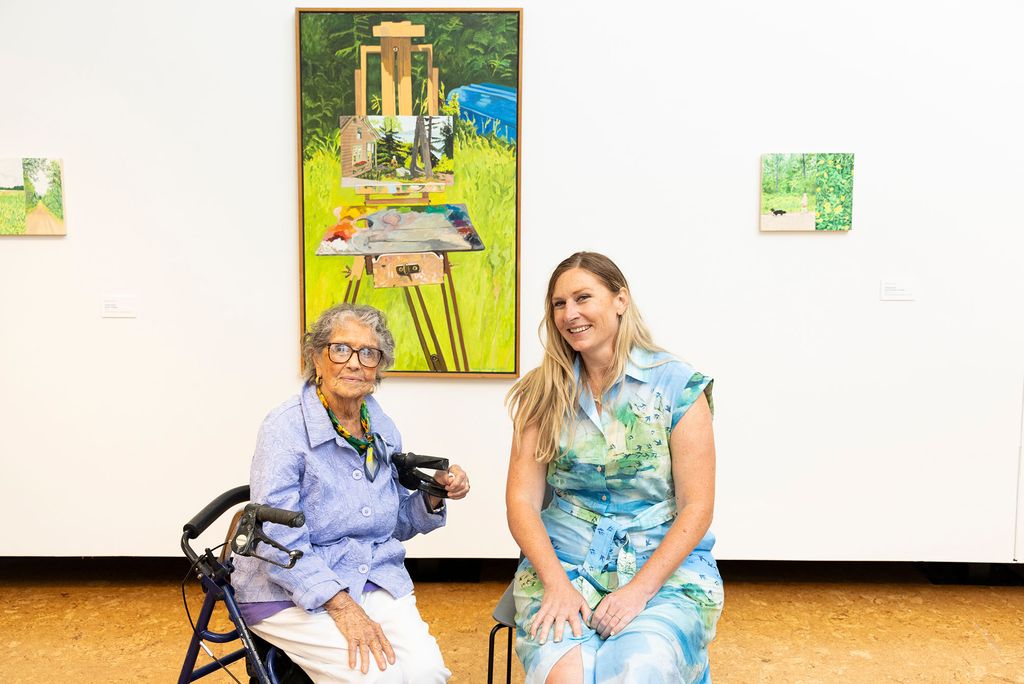New Stone Gallery Exhibition Proves You Can Go Home Again

New Stone Gallery Exhibition Proves You Can Go Home Again
A Summer Place, featuring paintings by Nancy Wissemann-Widrig and CFA’s Breehan James, is on view through August 10
A reception was held at the Faye G., Jo, and James Stone Gallery for A Summer Place, featuring paintings by Breehan James and Nancy Wissemann-Widrig, on July 11.
This article was originally published in BU Today on July 17, 2024. By Sophie Yarin. Photos by Jake Belcher
Comm Ave can be a sweltering expanse of concrete, car and bus exhaust, and limited shade, but step inside the air-conditioned Faye G., Jo, and James Gallery and you’ll find yourself transported to a tranquil, leafy idyll. A Summer Place, a new exhibition of paintings by Breehan James, a College of Fine Arts assistant professor of art, painting, and Nancy Wissemann-Widrig on view through August 10, is an “archive of everyday things and a window to nature’s close embrace,” says show curator Emily Lanctot, who selected an array of works created by the artists at their rustic summer homes.
Wissemann-Widrig’s award-winning artistic career spans decades. Now 95, she still paints every day. A family cottage named Cheerio, on the banks of the St. George River in Cushing, Maine, is the backdrop for her depictions of family life and the natural world, many created in the 1960s and ’70s, when her children were growing up. Her interior scenes invite the viewer to share a sense of coziness and intimate domesticity.
“When the kids were growing up, I couldn’t arrange to have a separate studio where they were never allowed to disturb my concentration. We were all living together and eating and playing cards and doing whatever we were doing,” she recalls. “I remember one of my sons saying, ‘Mom, you’re always in the way!’”
In her paintings, her family lounges on couches, plays cards, reads books in rooms with dark paneling or walls of windows. In her more placid still-life scenes, gauzy window curtains dance in the breeze, lush grass buzzes with insects, and sunlight kisses every surface.

James’ paintings are just as evocative at capturing the comfort of summer retreats, though she began to document her family’s Northern Wisconsin summer home, the Last Resort, in graduate school decades after Wisseman-Widrig first picked up a brush. James decided to turn the paintings of her family’s cottage on East Bass Lake into a longer-term project—a picture book—during the COVID-19 pandemic. (A professed fan of Wissemann-Widrig, she counts the artist’s Maine paintings among her influences.)
“I was trying to think about who I am in the world, the kinds of experiences I’ve had, and how this place reminds me of the things that are important to me,” she says, “whether it’s spending time close to nature, getting away from the habits of everyday life, disconnecting from my phone or the internet, reconnecting with people that are important to me, or just slowing down.”
Initially, James intended to paint solely still lifes, but after viewing an exhibition of Wissemann-Widrig’s work in Maine, where she now lives as well, she was inspired to include her loved ones in her work. She also had to admit to herself that the book project could take longer than she’d initially planned. “I thought it was so beautiful, the way you could see Nancy’s children grow [in her paintings],” she says. “So I decided this project would be finished in, like, 10 years.”
Pages from James’ forthcoming book are her contribution to A Summer Place, and many depict the natural world outside the Last Resort—a gingerbread confection of mahogany wood and yellow trim—lakes, forest paths, white birch trees, and native fauna.
James was also the engine behind A Summer Place: she reached out to Lanctot and suggested that there was enough commonality between the two artists’ process and treatment of the subject matter to make for a compelling exhibition. Lanctot was sold.
Nancy’s and Breehan’s paintings focus on everyday experiences that occur in multigenerational seasonal dwellings close to nature. Each artist understands how objects are imbued with emotion and how they carry narratives from the past into the future.
Both artists also opt to paint from life, which gives the viewer a richer sense of detail and proximity. It’s as if you’re experiencing an intimate, casual family scene, or the wild tableaux of the woodlands, alongside the painter.
Lanctot explains it this way: “A photograph offers a fixed position, stable light, and color, but when you observe things in the world, you feel the breeze, light shifts, and color changes, and you can get closer or move away from the thing you observe. All of the senses felt in the moment are part of the translation of the experience.”
This was certainly true for Wissemann-Widrig, who says the Cushing area has a long history of attracting prominent painters (Andrew Wyeth’s most famous work, Christina’s World, was painted there). “When the sun is shining, the light and shadow is very extreme, which is great for painters,” she says. “It also happened that my cottage had a fairly dark interior, so that when there was a blast of sunlight coming through the window, [the painting] was almost already composed for you.”
There is a tension between the immediacy of both artists’ paintings, their diaristic intimacy, and the fact that Wissemann-Widrig’s children are now middle-aged and that James now lives halfway across the country from her Last Resort cottage. Each is no longer a life-that-is, but a life-that-was, imbuing both artists’ works with a nostalgia for a time past and a world that is rapidly changing.

Rural sites come to life
A Summer Place is on view at Boston University Art Galleries’ Faye G., Jo, and James Stone Gallery, 855 Commonwealth Ave., through August 10. The gallery is open Tuesday through Saturday, from 11 am to 5 pm, and entry is free and open to the public.